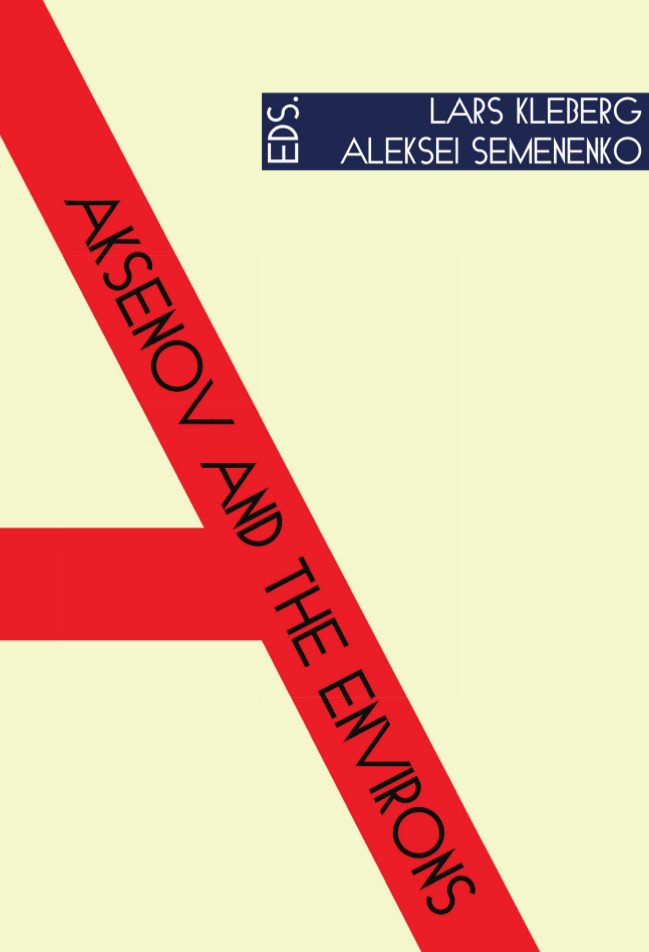Lars Kleberg, Aleksei Semenko (eds.): Aksenov and the Environs (2012) [Russian, English]
Filed under book | Tags: · art, art history, avant-garde, constructivism, futurism, literature, russia, theatre

“Ivan Aleksandrovich Aksenov (1883-1935), critic, poet, and translator, was an outstanding representative of the Russian avant-garde art.
In the 1920s, Aksenov was close to the constructivists and worked in the theatre of Vsevolod Meyerhold, also serving as the dean of its directors’ school. Aksenov’s analysis of the problems of mis-en-scène, more geometrical than ideological, influenced a new generation of directors, headed by Sergei Eisenstein.
For different reasons, Ivan Aksenov’s life and works have remained unknown outside a small circle of initiated readers. During the Soviet era, he was soon marginalized because of his engineer’s view of art and his anti-ideological position. Later, specialised scholars ignored him, finding it too difficult to grasp his versatile personality, which was both original and representative of the multi-faceted Russian avant-garde movement.
This book of essays by authors from nine different countries sheds light on the writer’s extraordinary contribution to Russian culture.”
Contributions by Lars Kleberg, John Bowlt, Nicoletta Misler, and Janne Risum are in English.
Publisher Södertörns högskola, Huddinge, 2012
Södertörn Academic Studies 52
ISBN 9186069543, 9789186069544
242 pages
via DiVA Academic Archive
Wendy Bark: Constructivist Costume, Textile & Theatrical Design, 1917-1934 (1995)
Filed under thesis | Tags: · 1910s, 1920s, 1930s, art history, constructivism, costume design, design, fashion design, textile design, theatre

This thesis follows the life of the art movement known as Constructivism through the turbulent post-revolutionary years, up to the onset of Socialist Realism, a doctrine imposed on the Arts by governmental directives. It focuses on the areas of fashion, textile and theatrical design, which themselves are strongly influenced by extra-artistic factors – economics, sociology and the historical era – as was the ethos of Constructivism.
After a brief introduction giving some background information on the art world and the main artist-designers of the study, the chapters go on to discuss the factors affecting the rise and then the waning popularity of the constructivist ideology, explaining the focal tenets of Constructivism, particularly in relation to fashion, textile and theatrical design. Since the majority of constructivist works were completed during the time span covered by NEP, those chapters relating to NEP have thus been given emphasis. Some biographical details about the main artists of the study are given at the end, and the Glossary lists the most common acronyms and abbreviations used in the text. The illustrations are intended as a companion to the text, since often the artistic effects of designers cannot be described adequately by language alone.
The study focuses on six artist/designers: Vladimir Tatlin, Alexander Rodchenko, Varvara Stepanova, Liubov Popova, Alexandra Exter, and Nadezhda Lamanova.
Full title: Constructivist Costume, Textile & Theatrical Design, 1917-1934: A Study of Constructivism Set in the Socio-cultural, Political and Historical Context of Post-Revolutionary Russia
Masters thesis
Durham University
285 pages
James M. Harding, John Rouse (eds.): Not the Other Avant-Garde: The Transnational Foundations of Avant-Garde Performance (2006)
Filed under book | Tags: · africa, argentina, art history, avant-garde, fluxus, india, japan, mexico, middle east, music history, performance, performance art, theatre

“Almost without exception, studies of the avant-garde take for granted the premise that the influential experimental practices associated with the avant-garde began primarily as a European phenomenon that in turn spread around the world. These ten original essays, especially commissioned for Not the Other Avant-Garde, forge a radically new conception of the avant-garde by demonstrating the many ways in which the first—and second—wave avant-gardes were always already a transnational phenomenon, an amalgam of often contradictory performance traditions and practices developed in various cultural locations around the world, including Africa, the Middle East, Mexico, Argentina, India, and Japan. Essays from leading scholars and critics—including Marvin Carlson, Sudipto Chatterjee, John Conteh-Morgan, Peter Eckersall, Harry J. Elam Jr., Joachim Fiebach, David G. Goodman, Jean Graham-Jones, Hannah Higgins, and Adam Versényi—suggest collectively that the very concept of the avant-garde is possible only if conceptualized beyond the limitations of Eurocentric paradigms.
Not the Other Avant-Garde is groundbreaking in both avant-garde studies and performance studies and will be a valuable contribution to the fields of theater studies, modernist studies, art history, literature, and music history.”
Publisher University of Michigan Press, 2006
Theater: Theory/Text/Performance series
ISBN 0472069314, 9780472099313
312 pages
PDF (updated on 2017-7-11)
Comment (0)
